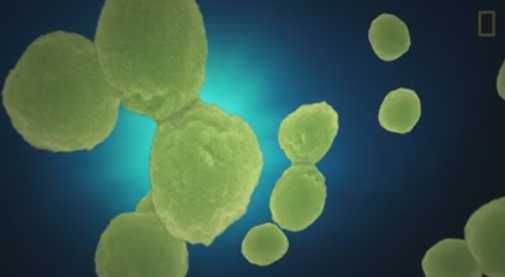File:Chlorophyll in the oceans and vegetation on land world map 2003 NASA-Goddard.jpg: Difference between revisions
Siterunner (talk | contribs) No edit summary |
Siterunner (talk | contribs) No edit summary |
||
| Line 3: | Line 3: | ||
''Chlorophyll in the oceans and vegetation on land throughout the world. Low levels of chlorophyll in the ocean are purple and blue and progressively levels are indicated by green, yellow, and red. Areas of land with the densest vegetation are blue-green...'' | ''Chlorophyll in the oceans and vegetation on land throughout the world. Low levels of chlorophyll in the ocean are purple and blue and progressively levels are indicated by green, yellow, and red. Areas of land with the densest vegetation are blue-green...'' | ||
''http://www.genomenewsnetwork.org/articles/09_03/ocean.shtml'' | * ''http://www.genomenewsnetwork.org/articles/09_03/ocean.shtml'' | ||
''Prochlorococcus is a phytoplankton, a tiny plant-like bacteria that is less than a micron wide and exists at the very bottom of the ocean’s food chain. Lay 100 of them end to end and they would be as wide as a human hair...'' | ''Prochlorococcus is a phytoplankton, a tiny plant-like bacteria that is less than a micron wide and exists at the very bottom of the ocean’s food chain. Lay 100 of them end to end and they would be as wide as a human hair...'' | ||
| Line 14: | Line 12: | ||
:''~ from '''''"The World Is Blue: How Our Fate and the Ocean’s Are One"''''' by Sylvia Earle / National Geographic'' | :''~ from '''''"The World Is Blue: How Our Fate and the Ocean’s Are One"''''' by Sylvia Earle / National Geographic'' | ||
[https://en.wikipedia.org/wiki/Prochlorococcus '''''Prochlorococcus'''''] | [https://en.wikipedia.org/wiki/Prochlorococcus '''''Prochlorococcus'''''] | ||
| Line 20: | Line 17: | ||
[[File:Prochlorococcus blue-green.tiny ones.png]] | [[File:Prochlorococcus blue-green.tiny ones.png]] | ||
'''''"The Tiny Little Ones - Plankton"''''' | '''''"The Tiny Little Ones - Plankton"''''' | ||
| Line 28: | Line 24: | ||
:'''''Nearly all marine plants are single celled, photosynthetic plankton-algae''''' | :'''''Nearly all marine plants are single celled, photosynthetic plankton-algae''''' | ||
○ | |||
| Line 49: | Line 45: | ||
[[Category:Microbiology]] | [[Category:Microbiology]] | ||
[[Category:Microorganism]] | [[Category:Microorganism]] | ||
[[Category:Nature]] | |||
[[Category:Oceans]] | [[Category:Oceans]] | ||
[[Category:Ocean Ecosystem]] | [[Category:Ocean Ecosystem]] | ||
Revision as of 18:39, 1 July 2018
Chlorophyll in the oceans and vegetation on land throughout the world. Low levels of chlorophyll in the ocean are purple and blue and progressively levels are indicated by green, yellow, and red. Areas of land with the densest vegetation are blue-green...
Prochlorococcus is a phytoplankton, a tiny plant-like bacteria that is less than a micron wide and exists at the very bottom of the ocean’s food chain. Lay 100 of them end to end and they would be as wide as a human hair...
"A single kind of blue-green algae in the ocean produces the oxygen in one of every five breaths we take"
- ~ from "The World Is Blue: How Our Fate and the Ocean’s Are One" by Sylvia Earle / National Geographic
"The Tiny Little Ones - Plankton"
- "Ecosystems of the Sea"
It is estimated that marine plants produce between 70 and 80 percent of the oxygen in the atmosphere
- Nearly all marine plants are single celled, photosynthetic plankton-algae
○
File history
Click on a date/time to view the file as it appeared at that time.
| Date/Time | Thumbnail | Dimensions | User | Comment | |
|---|---|---|---|---|---|
| current | 14:46, 2 May 2016 |  | 450 × 220 (33 KB) | Siterunner (talk | contribs) |
You cannot overwrite this file.
File usage
The following 3 pages use this file:
- Atmospheric Science
- Biodiversity
- Biogeosciences
- Citizen Science
- Climate Change
- Climate Policy
- Earth Observations
- Earth Science
- Earth360
- Ecology Studies
- Ecoregions
- Environmental Security
- Extinction
- Fisheries
- Green Graphics
- Microbiology
- Microorganism
- Nature
- Oceans
- Ocean Ecosystem
- Ocean Science
- Ocean Sustainability
- Planet Citizen
- Planet Scientist
- Planet Citizens, Planet Scientists
- Whole Earth
